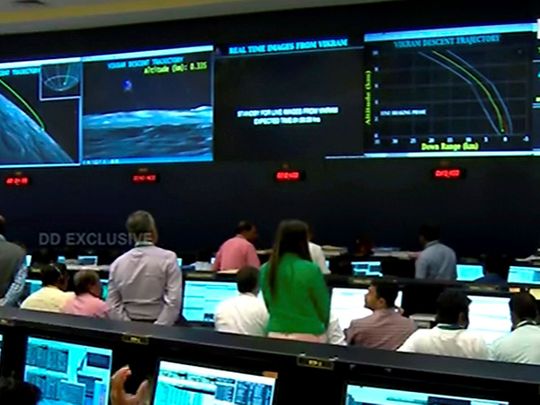
Bengaluru: Isro is racing against time to bring Vikram back to life and salvage the lander-rover part of the Chandrayaan-2 mission.
The lander Vikram, with rover Pragyan tucked inside it, lost communication with ground stations during its final descent, just 2.1km above the lunar surface and minutes before the planned soft landing in the early hours of Saturday.
Isro (Indian Space Research Organisation) said on Sunday Vikram had a “hard landing”.
The Bengaluru-headquartered space agency on Tuesday again confirmed that the lander has been located on the lunar surface by the on-board cameras of the Chandrayaan-2 orbiter which is circling the moon in its intended orbit.
“All possible efforts are being made to establish communication with (the) lander,” Isro further said in a tweet.
A senior Isro official associated with the mission said: “The images from the orbiter camera showed that Vikram is in single piece lying on the lunar surface; not broken into pieces. It is in a tilted position. It’s not in its four legs, as usual.”
This official added on condition of anonymity: “It’s not upside down. It’s lying on its side”.
Isro officially did not comment on the condition of the lander.
Chandrayaan-2 comprises an orbiter, lander (Vikram) and rover (Pragyan).
The mission life of the lander and rover is one lunar day, which is equal to 14 earth days.
Isro Chairman K Sivan said on Saturday evening that the space agency would try to restore the link with the lander for 14 days and it has been reiterating the resolve since then.
An Isro official said Vikram hit the lunar surface at a place about 500 metres away from where it was originally planned to touchdown.
Sources said an Isro team is trying to see if they can reorient the antennas of the lander in such a way that communication can be restored.
“Efforts are going on,” they said.
According to a senior Isro official, orientation may have been lost during the final descent when velocity was reduced, due to “sensor or on-board software or computer anomaly”.
“A committee is looking into what has gone wrong. They will come out with answers soon,” this official said.
Meanwhile, a precise launch and efficient management of the Chandrayaan-2 mission — until the lander Vikram lost communication with ground stations — has paid rich dividends to Isro on the orbiter front.
The 2,379kg orbiter whose mission life was designed to be one year would now be able function for almost seven years.
“Enough fuel is available with the orbiter. Up to [lunar] orbit insertion, we did not have any flaw. Additional fuel which was anticipated was not used at all. Everything went as per the plan. Additional fuel is available with us [on-board the orbiter],” an Isro official said.
Another Isro official said: “One of the limiting factors is on-board fuel availability. Because the performance of GSLV-MK III [which launched the spacecraft] and efficient mission management, we have enough fuel for continuing it forward for seven years.”
Isro had said 90 to 95 per cent of the Chandrayaan-2 mission objectives were accomplished and it would continue to contribute to lunar science.












